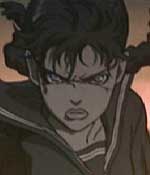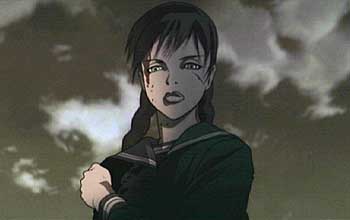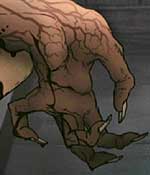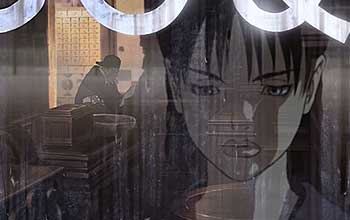
Production I.G staff member Kenji Kamiyama has served as the animation director for "Jin-Roh," the storyboard artist for "Medarot 2" and has since written the script for "Wild Arms." Akadot's Sara Ellis was able to speak with him at Production I.G's offices in Kokubun-ji, Tokyo about "Blood," "Jin-Roh" and his thoughts on the anime industry at large.
"Blood" is short at 45 minutes. Is there more to the story or are there parts that were omitted or not filmed?
Kenji Kamiyama: "Blood" wasn't originally meant to be a theatrical release but one for video. We were thinking about a three-part video release. Our first idea was that "Blood" was going to be the middle of a three part series. The first part was going to take place in immediate post war Japan, and the third would have taken place during the present, or the 1990s.
What was the reason for setting the story at a U.S. military base? Were you thinking about the various conflicts arising from the U.S. military presence in Okinawa and other parts of Japan?
KK: During the initial planning stages we weren't thinking of that at all. The reason we set it on a U.S. base is that Japan is an island country, so it doesn't have any borders really. The 'fence' around Japan that the U.S. military bases have created is in fact the only real borderline that has been drawn around us. These borders create a certain kind of tension. We were thinking of that when we set the story on a military base. Honestly, we weren't really thinking about making any kind of political statement.
All the other kids are wearing civilian clothes. Why is Saya the only one with a Japanese school uniform? Is there a symbolic meaning to her being in a school uniform?
KK: One of the reasons we have Saya in a school uniform is that the school uniform is sort of a semiotic sign in Japanese animation. By putting Saya in the uniform our audiences would immediately recognize her as the vampire hunter. The second reason is that the sailor uniform is used so often in Japanese animation that we wanted to create a sort of paradox. It creates the sense of misunderstanding or falsehood about her and the organization backing her up. We wanted a sense of parody, it's not an attractive uniform, it's certainly not practical for her to wear, but despite all of this she's misunderstood her surroundings and is wearing it anyway.

Will the video game clear up any story points or expand upon themes touched on in the movie?
KK: We planned to make the video game from the initial planning stages of the movie. The first advantage of the video game was probably that as an adventure game it would have more information than the film. We thought the game would be the most suitable media to establish the story of the vampire and of Saya. There's an enormous amount of information in it. At the time I was working on it, however, I wasn't thinking about telling more of the story but giving a basis for the player to feel more involved in the game.
Allow me to shift focus for a moment to "Jin-Roh," on which I know you served as animation director. Since you say Production I.G. didn't consciously make any political statements in "Blood," is the same true for "Jin-Roh?" Does "Jin-Roh" tap into any fears about a police state or a descent into anarchy?
KK: I'm often asked about that, but to be honest, we weren't really conscious of that. We were simply trying to create a post-war atmosphere, a historical situation, and a group from which the solitary hero could suddenly discover his individuality, along with the girl who meets him. The post-war background was suitable for creating the situation and setting in which these characters could meet. We weren't really trying to make any kind of ideological statement.
Both "Blood" and "Jin-Roh" contain brutal imagery. In America people tend to be very vocal in their objections toward sex and violence in entertainment. How often does this problem arise with Japanese animation?

KK: This problem is rather common. Mothers don't want to show certain programs to their children and such. People often associate animation with Disney and see it as something they can show their kids without worrying about. One of the reasons is that Japanese animation is created ignoring taboos. I'm not sure about how they feel over in America, but we think the unusual breaking of taboos in Japanese animation is one of the reasons it is doing well abroad. Of course I don't necessarily think that sex and violence itself has a good influence on people, but the way in which taboos are broken, the novelty that lies even outside of the sex and the violence, creates new ways of expression which are seen as new even in Japan. Personally I think that animation should keep evolving, going beyond providing mere stimulation by creating new forms of expression. There's going to continue to be material that will be considered objectionable but if it continues to just aim for simple shock value it will neither break taboos nor remain fresh for audiences.
On a more general note, Americans typically like their endings to be conclusive and clear while the Japanese seem to prefer subtler more ambiguous endings. Why do you think this difference exists? Why do the Japanese like ambiguous endings?
KK: If the film ends conclusively, then it won't leave behind any reverberations or after-affects in the audience. It's just like getting on a jet-coaster in a movie theatre, having a good scream, and saying, "Ah that was fun!" then forgetting about it. I don't think movies are meant to just serve that purpose. A happy or a pat ending definitely provides a sense of catharsis at the end and I think that that is important. Most filmmakers are aiming for that in one way or another. From a Japanese perspective that's just a little too simple, or a dry way to end a picture. Things just don't end that perfectly, if somebody dies people will grieve, or after the movie ends the couple isn't necessarily going to live happily ever after. Sooner or later there's a good chance they'll break up. We want audiences to think about what happens after the movie ends. We want them to think more about the film.

What effect, good or bad, do you think computer graphics (CG) have on the quality of Japanese animation?
KK: On the bright side, "Blood" benefited greatly from CG. We could do a lot of effects that we weren't able to do previously. As far as the bad side of things goes, Japanese animation is an art form that we feel very proud of, a craft that we can hold up to the world. But since CG has entered the picture, the method of animation by hand has gradually and will continue to go into decline. It seems like many of the young people entering the industry are aiming for CG first. I can't really predict what will happen in the future but it's something that I do worry about. However, on the other hand CG is helping animators find new forms of expression, so that's an upside.






